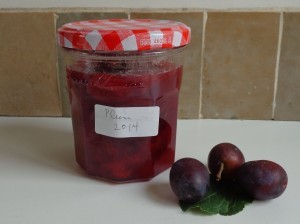Plum jam
This recipe makes a jam that is slightly tart and slightly liquid. For a thicker, sweeter jam, add an extra cup (200 g.) sugar. There is no need for paraffin or any other covering for the jam — clean jars with tight-fitting lids are all that is required, as explained below.
As for which plums to choose, the fresher the better, and go for wild varieties rather than mass-cultivated if at all possible. I used small blue plums, which take longer to pit (more plums per pound/kilo) but which deliver a delightfully tangy jam. But any kind of plum — blue damsons, green greengage, red plums, even tiny yellow mirabelles — will work well with this recipe.
Serve the jam with toast, blinis or other pancakes, or simply with fresh bread and butter. It also goes well in small quantities alongside duck or game.
2-1/4 pounds (1 kilo) fresh plums
3 cups (600 g.) sugar
First, prepare your jam jars. They should be perfectly clean and ready to go. For this quantity of fruit, you will need four 1-pint (500 g.) jars with tight-fitting lids, or the equivalent — for example, three 1-pint jars and two 1/2-pint jars.
Set the jars on a counter near the stove, along with a clean cotton tea towel/dish towel (not terry cloth). You will also need two large pots. Fill one halfway with water for sterilizing the jars and set it on the stove, but wait to turn on the heat.
Next, prepare the plums. Rinse them off, shake or pat dry and remove the pits. Place the plums in the jam pot. Cover with the sugar and stir. Let them rest in the sugar for 15 minutes before proceeding.
While the plums are resting, sterilize the jam jars. Bring the pot of water to a boil over high heat. When the water is boiling merrily, add the jars and, separately, their lids. You may have to do this in two rounds if all the jars won’t fit in the pot at once. To immerse the jars, lay them in sideways and then turn them upright, using a fork or spoon, so that they are at least halfway filled with water. Allow to boil for 3 minutes. Remove the jars and lids — very carefully, so as not to burn yourself with boiling water. I usually do this using a fork and spoon, tipping the jar to let the water run out. Place the sterilized jars upside-down on the clean tea towel, with the lids beside them.
Now place the pot with the plums on the stove over medium-high heat and allow it to come to a boil, stirring regularly to prevent sticking. When the jam comes to a rollicking boil, turn down the heat to medium — otherwise, the jam could boil right out of the pot. Allow to cook for 15 minutes, stirring occasionally.
Now comes a key question: Do you need to skim off the foam that forms as the jam is cooking? My answer is, no, you don’t. This is quite an unorthodox view in France, where jam-makers skim and skim again, but I have found over years of jam-making that it is unnecessary and results only in removing spoonfuls of delicious jam from the pot. Instead, I wait until the jam is nearly done cooking, turn the heat down to low so that it stops boiling, and gently remove whatever foam remains, usually very little.
Now comes the crucial moment. While the jam is still extremely hot — in other words, right away — ladle it into the clean pots, leaving a margin of about half an inch (2 cm) between the top of the jam and the top of the jar. Immediately place the lids on the jars. Quickly wipe off the jars with a sponge to remove any jam on the sides. And now, using your tea towel to protect your hands from the heat, screw the lids on as tightly as possible.
As the jam cools, a vacuum will form — and this will protect your jam for years to come. Of course, if jam is as popular in your house as it is in mine, your few jars may not last for years or even months. But it’s always a pleasure to set a couple of jars aside for later, and then to remember the joys of summer on a cold winter’s day.






You do not mention water in with the jam & sugar??? Any water? How much?
Hi Anne. No water is needed! Plums are generally very juicy, and they will release their juice during the cooking process. Some juice can be release ahead of time by letting the plums sit in the sugar for a bit before cooking, as mentioned in the recipe. The main issue with plum jam is making sure that it’s not too liquid at the end of the cooking process. So yes — no water. Hope this helps. Best, Meg